Themes > Features
30.11.1999
Agriculture Trade Policy : The Case for Caution
Even though agriculture has been the sector least affected by the
reforming zeal that overcame successive government's since 1991,
substantial headway has been made in this sector as well. The Finance
Ministry's Economic Survey 1993-94 summarised the case for and the extent
of liberalisation of agricutural trade as follows: "Indian farm products
are characterised by extremely low import content compared to non-farm
exportables. Exchange rate convertibility on the trade account has
therefore enabled many farm-based products to become internationally
competitive. Rice, wheat, cotton, fruits and vegetables and flowers are
some of the non-traditional exportables. Some of the measures initiated
recently to accelerate the growth of agricultural exports are : (i)
minimum export price (MEP) on basmati rice, pepper, guargum, orchids and
meat of sheep, goat and buffalo has been removed; (ii) exports of milk
products have been decanalised; (iii) permission has been granted to
freely export superfine non-basmati rice subject to an MEP which has been
reduced to $200 per tonne; (iv) exports of mustard seeds and rapeseds have
been allowed against quota; (v) exports of wheat products have been
decontrolled and exports of high value durum wheat and of non-FAQ jowar
permitted subject to ceiling; and (vi) cession of sugar exports has been
waived and cess on pepper exports suspended." Since then further advances
with regard to liberalisation have been made, culminating in the sweeping
liberalisation implicit in the Export-Import Policy announced in April
this year.
Exports of agricultural products initially appeared to respond to these moves, rising from $3136 million in 1992/93 to $4023 million in 1993/94, $4227 million in 1994/95, $6119 million in 1995/96 and $6868 million in 1996/97. This initial post-reform buoyancy in exports led to considerable optimism about the likely effect of the Uruguay Round agreement on India's agricultural sector. The stipulations that developed countries should reduce production subsidies paid to their farmers and roll-back non-tariff barriers restricting agricultural trade were expected to substantially benefit India, because of the comparative advantage she had in the area. It is the persistence of that optimism which underlies the widespread perception that it would be to India's advantage if there are further advances made with regard to liberalisation of agricultural trade in the proposed new Round of trade negotiations.
Such optimism notwithstanding, there are reasons to be less sanguine about India's agricultural-export potential. To start with, more recently agro-product exports seem to be slipping, having touched $6633 million in 1997/98 and $5994 million in 1998/99, compared to the peak of $6868 million in 1996/97. Further there are signs that the price advantages that India had in the world markets for some commodities like rice and cotton are diminishing. This is significant because these were the two commodities which were expected garner major gains from liberalisation. In an early analysis of the impact of trade liberalisation on agriculture, Deepak Nayyar and Abhijit Sen argued as follows: "Clearly, as with any liberalisation, there will be gainers and losers from agricultural trade in India. The most obvious way of looking at this is to say that the gainers would be the producers of crops such as rice and cotton which are currently priced below world prices and consumers of goods such as sugar and oilseeds which are currently priced above world prices." (See "International Trade and the Agricultural Sector" in G.S. Bhalla (ed.), Economic Liberalisation and Agriculture 1994). While developments in the rice and cotton trade are questioning this judgement, in areas like oilseeds and vegetable oils, where India was not internationally competitive, but moving towards a high degree of self-sufficiency on the basis of domestic production aided by protection, liberalisation is having rather devastating consequences.
The immediate post-reform buoyancy in agricultural exports was in large measure due to a sharp increase in the export of rice. As Chart 1 shows, rice exports which were mildly buoyant during 1992-94, registered a huge jump in 1995-96, with exports rising five-fold by more than four million tonnes in that one year. Almost all of that increase was a result of the export of non-basmati varieties which, because of export restrictions in earlier years, did not feature as a major export from India . As Chart 3 shows the buoyancy in rice exports was almost wholly responsible for the buoyancy in foodgrains exports. However, the rice export boom of 1995-96 proved to be exceptional. It was followed by a sharp fall over the next two years. Though there are signs of a second revival in 1998-99, with rice exports estimated at 4.7 million tonnes as compared with the 1995-96 peak of close to 5 million tonnes, there are reasons to believe that such buoyancy may not be sustained.
Exports of agricultural products initially appeared to respond to these moves, rising from $3136 million in 1992/93 to $4023 million in 1993/94, $4227 million in 1994/95, $6119 million in 1995/96 and $6868 million in 1996/97. This initial post-reform buoyancy in exports led to considerable optimism about the likely effect of the Uruguay Round agreement on India's agricultural sector. The stipulations that developed countries should reduce production subsidies paid to their farmers and roll-back non-tariff barriers restricting agricultural trade were expected to substantially benefit India, because of the comparative advantage she had in the area. It is the persistence of that optimism which underlies the widespread perception that it would be to India's advantage if there are further advances made with regard to liberalisation of agricultural trade in the proposed new Round of trade negotiations.
Such optimism notwithstanding, there are reasons to be less sanguine about India's agricultural-export potential. To start with, more recently agro-product exports seem to be slipping, having touched $6633 million in 1997/98 and $5994 million in 1998/99, compared to the peak of $6868 million in 1996/97. Further there are signs that the price advantages that India had in the world markets for some commodities like rice and cotton are diminishing. This is significant because these were the two commodities which were expected garner major gains from liberalisation. In an early analysis of the impact of trade liberalisation on agriculture, Deepak Nayyar and Abhijit Sen argued as follows: "Clearly, as with any liberalisation, there will be gainers and losers from agricultural trade in India. The most obvious way of looking at this is to say that the gainers would be the producers of crops such as rice and cotton which are currently priced below world prices and consumers of goods such as sugar and oilseeds which are currently priced above world prices." (See "International Trade and the Agricultural Sector" in G.S. Bhalla (ed.), Economic Liberalisation and Agriculture 1994). While developments in the rice and cotton trade are questioning this judgement, in areas like oilseeds and vegetable oils, where India was not internationally competitive, but moving towards a high degree of self-sufficiency on the basis of domestic production aided by protection, liberalisation is having rather devastating consequences.
The immediate post-reform buoyancy in agricultural exports was in large measure due to a sharp increase in the export of rice. As Chart 1 shows, rice exports which were mildly buoyant during 1992-94, registered a huge jump in 1995-96, with exports rising five-fold by more than four million tonnes in that one year. Almost all of that increase was a result of the export of non-basmati varieties which, because of export restrictions in earlier years, did not feature as a major export from India . As Chart 3 shows the buoyancy in rice exports was almost wholly responsible for the buoyancy in foodgrains exports. However, the rice export boom of 1995-96 proved to be exceptional. It was followed by a sharp fall over the next two years. Though there are signs of a second revival in 1998-99, with rice exports estimated at 4.7 million tonnes as compared with the 1995-96 peak of close to 5 million tonnes, there are reasons to believe that such buoyancy may not be sustained.



Consider for example trends in the domestic and export prices (f.o.b.) of rice . The period since 1992-93 has on average been characterised by a widening of the price differentials between domestic and exports sales. As a result, when the government permitted export of non-basmati varieties, the higher price to be garnered from the export market encouraged a diversification of supplies to the world market, strengthening the view that India had substantial comparative advantages in rice production. However, in absolute terms international prices have been falling during the later part of this period. According to the Commission for Agricultural Costs and Prices, the unit value realised for export of non-basmati rice declined from Rs. 9677 ($272.6) per tonne in 1996-97, to Rs. 9603 ($258.4) in 1997-98 and further to Rs. 9429 ($221.9) in 1998-99 (April-Nov.). These prices were in fact less than the economic cost of providing rice incurred by the FCI and only about 10-20 per cent higher than the levy prices in the many states. This suggests that so long as the rate of increase in support prices is higher than any depreciation in the value of the rupee, the price advantage that Indian rice exporters enjoy could be eroded.
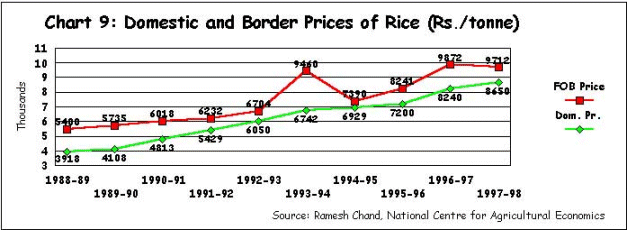
Rice has dominated foodgrain exports because of the restrictions that apply on exports of wheat and coarse grains. While the export of rice is permitted freely, wheat and coarse grain exports require a licence and are subject to quantitative restrictions. The ceiling for exports of these commodities are determined based on domestic availability and were, for example, set at one lakh tonnes each in 1998-99. So long as these ceilings remain in place, export trends do not reflect India's competitive advantage in these areas, but relative price comparisons suggest that in the case of wheat , the advantages that prevailed during the period 1993-94 to 1995-96 have since been lost.
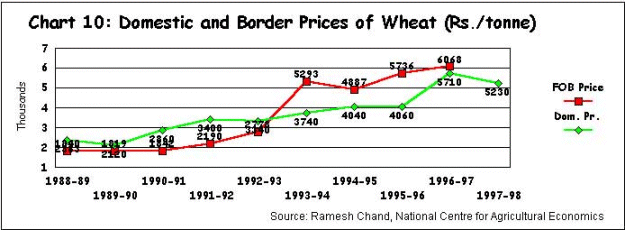
Another crop which was considered a major agricultural exportable from India is raw cotton. Hitherto, cotton exports have been regulated under a policy which provided for exports of about 5 lakh bales (of 170 kg each) a year. In practice, export volumes are influenced by domestic supply conditions and have tended to vary substantially. During the 1990s, exports touched a peak of 16.8 lakh bales in cotton year 1996-97 , when production was also at a record high of 178 lakh bales. What is noteworthy however is the buoyancy in cotton imports in recent seasons, with imports rising from a low of 0.3 lakh bales in 1996-97 to 4 lakh bales in 19987-98 and a projected record level of 6.5 lakh bales and an estimated actual export of around 5 lakh bales in 1998-99. Interestingly, as Chart 8 shows, in two of these three years (1997-98 and 1998-99) the price differential between comparable Indian and foreign varieties of cotton have (in the one case cited) virtually disappeared. In all previous years during the 1990s, international prices have consistently ruled higher than domestic prices. The erosion of the price differential is more due to the decline in international prices rather than any significant rise in domestic prices, suggesting that international price trends in the case of this commodity, considered a potential foreign exchange earner for India, have moved in directions which have undermined India's competitive advantage.
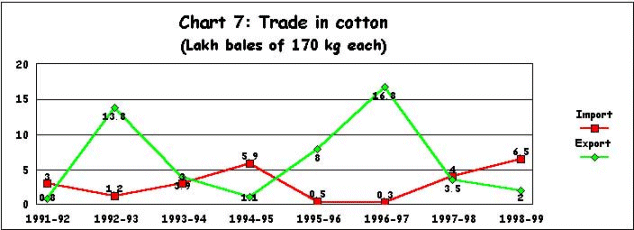
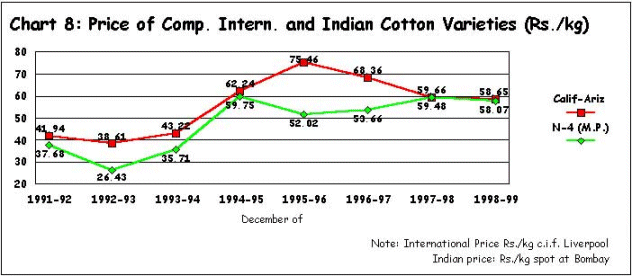
More recent evidence indicates that the problem is unlikely to disappear. It is estimated that imports would be even higher in the current cotton year, despite the fact that the Cotton Advisory Board has projected output at 175 lakh bales in 1999-2000, as compared with 163.5 lakh bales in the previous year. Further, initial stocks this year are placed at 49 lakh bales as compared with 36.5 lakh bales in 1998-99. High production and larger initial stocks suggest that cotton prices would rule much lower during the coming cotton season. In fact, reports from different parts of the country indicate that cotton prices have fallen by 10-20 per cent during November. Yet, cotton imports during the current season have been projected at 8 lakh bales, compared with 5 lakh bales in the previous year, because imported cotton enjoys both price and quality advantages. The problem is that with international prices easing as well, it is expected that the price parity between domestic and imported cotton is unlikely to be disturbed during the year, resulting in a persistence of the import surge.
All in all, therefore, recent trends do suggest caution when claiming that India would benefit substantially from agricultural trade liberalisation. The experience with two of the commodities considered front runners in terms of competitive advantage, namely rice and raw cotton, reflects price and trade trends which suggest that such advantage is tenuous to say the least.
While foreign exchange gains from agricultural trade liberalisation are thus uncertain, there are signs that losses in terms of additional post-liberalisation outflows on account of imports can be significant. While imports of cereals are in general canalised through the Food Corporation of India, coarse and common varieties of rice and rice with 50 per cent broken content are allowed to be imported freely. All cereal imports are not subject to any duty. Chart 4 shows that during the 1980s, foodgrain imports were extremely volatile, rising sharply in the wake of bad or indifferent harvests of the kind seen in 1979-80, 1982-83, and 1987-88. Thus import movements were clearly related to domestic production trends. While this remained partly true in the 1990s, there has been a tendency for imports to rise after 1995-96 and remain at moderately high levels. From a low level of just 8.3 thousand tonnes in 1995-96, cereal imports rose to 6.1 lakh tonnes in 1996-97, 14.9 lakh tonnes in 1997-98 and 11.5 lakh tonnes in the first eight months of 1998-99. Almost all of these imports were of wheat, since there were virtually no imports of rice during 1996-97 and
1998-99.

In the food products area, the real impact of liberalisation has occurred in vegetable oils. Though oilseeds imports are permitted, imports take the form of edible oils, which are freely importable except for coconut oil, RBD palm oil, RBD palm stearine and palm kernel oil, which till April 1, 1999 were canalised imports. As Chart 5 shows, imports of edible oils rose sharply from 103,000 tonnes in 1992-93 to 347,000 tonnes in 1994-95, 1.06 million tonnes in 1995-96 and 1.42 million tonnes in 1996-97. Though imports dipped slightly to 1.14 million tonnes in 1997-98, they rose sharply again and stood at 1.71 million tonnes during the first eight months of 1998-99.
These imports occurred despite a continuous rise in the unit value of edible oil imports from Rs. 6.2 per kg. in 1990-91 to Rs. 30.13 per kg. in 1998-99. While a part of this increase in the unit vale of exports may be on account of a shift to higher value oils in the import basket, the data suggest that a combination of taste changes and domestic price trends have worked against the domestic oilseeds and vegetable oil producers. In one instance, viz. soyabean oil, where, according to one estimate, earlier price relatives where in favour of the domestic trade once again a rise in domestic prices has eroded the price differential, rendering imports an attractive option.
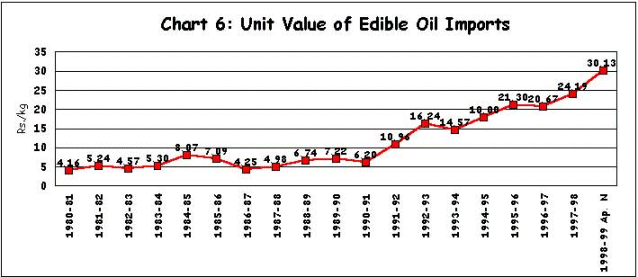

The situation appears to be deteriorating rapidly. According to the Solvent Extractors' Association of India, the import of vegetable oils during the oil year 1998-99 stood at 4.39 million tonnes, which was more than double the figure of 2.08 million tonnes in the previous year. Quoting Oil World weekly, they argue that imports during 1999-2000 could be as high as 4.7 to 4.9 million tonnes. Refined palmolein reportedly accounts for around 60 per cent of these exports.
Overall India's weakening competitive edge in recent times is essentially the result of a sharp decline in international prices. The international prices of agricultural commodities, which registered a sharp rise during 1992-96, have recorded an even sharper fall since then, taking them to a decadal low. According to the food and agricultural raw materials price indices of the International Monetary Fund, prices fell by 13 and 16 per cent in 1998, after similar declines in the previous year. Prices are projected to fall further in 1999.
It is not just the fall in prices that is a matter of concern, but the inter-commodity variations in impact of imports on domestic prices. With pulses and edible oil imports being placed under OGL as part of liberalisation, the real prices of these commodities have either declined or remained stagnant. On the other hand, there are crops which have seen increase in prices in real terms during these years. This obviously results in a shift of acreage away from certain crops to others, making India increasingly import dependent in some areas. At one level, this is a matter of concern from the point of view of food security, since it is likely that prices would remain high for various commercial crops that have a large international demand while remaining low for a range of food crops. But that is not all. Trade liberalisation could lead to substantial instability. Since India's large demand for particular commodities is likely to affect international prices substantially, a shift out of one crop in domestic production and in its favour in imports could trigger prices increases that induce acreage shift reversals. Such price and output instability is hardly the recipe for building competitive capabilities, which is the ostensible aim of liberalisation.
These possibilities that trade liberalisation could adversely affect agriculture need to be viewed in the light of evidence which suggests that the overall benefits to agriculture from liberalisation have thus far been limited. One fall out of overall trade liberalisation was to be a shift in the terms of trade between agriculture and manufacturing in favour of agriculture, as a result of a fall in manufactured goods prices and a rise in agricultural prices. However, as Chart 12 shows, while the terms of trade have been in favour of agriculture during the 1990s, the gains in those terms were registered during the 1980s and not the 1990s. During the 1990s, the terms have trade have fluctuated around a more or less stagnant trend, and have equalled the 1991-92 level only in one other year. And if our analysis of the likely price consequences of liberalisation materialise, there is a possibility of a decline in those terms in the years to come.
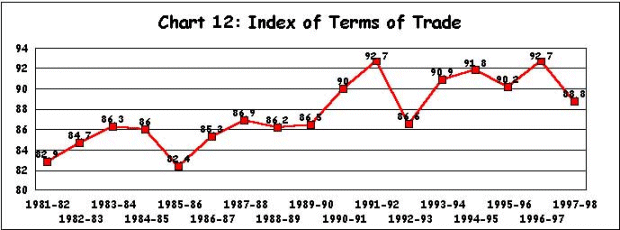
In sum, liberalisation of trade, even to the extent that it had proceeded before the Exim policy announced in April this year, has not delivered the promise of benefits to agriculture that it held out. On the other hand, there are signs that the consequences for agriculture could prove adverse in future. The case for caution while advocating further liberalisation of agricultural trade either at home or at the WTO is therefore obvious.
© MACROSCAN 1999